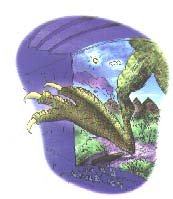|
________________
CM . . . .
Volume VI Number 9 . . . . January 7, 2000
Next, the book highlights ten different topics, or areas, which kids might like to explore in more
detail. The topics pages contain a few short pieces outlining related trivia, suggestions to help
focus a millennium collection, and blank space for making lists and attaching items. The
numerous, short suggestions encourage creativity by allowing the reader to focus on and develop
those of most interest.
The colloquial language and style make the book an easy non-threatening read, although
occasionally the text is too self-consciously cool. The topic areas tend to be very computer
technology and media oriented, with the internet or other mass media coming up in five of the
ten topics. Fortunately, the issues surrounding the internet and other modern media are not
trivialized. Warnings are given about the legal aspects of downloading music off the internet,
about how media advertising is designed to draw you in, and about not giving away personal
information on Internet chat lines.
I suspect that the emphasis on media and communications technology is an attempt to spark
interest in today's kids who are so frequently exposed to television and video games.
Unfortunately, the focus on technology also means that other interesting areas, like geography,
politics, or art, do not get a mention. Additionally, in its attempt to seem cutting edge and
hip, the book spends time on some items that would only be relevant to a small number of
potential readers and which could, in fact, make some kids feel left out. For instance, in the
section on computers (largely dedicated to video games), the book suggests listing or describing
your own home/school computer equipment. There are large numbers of children who have
neither and who are not going to feel particularly "cool" about it. A better idea, and one that
requires kids to use their imagination more, is the suggestion that kids list their ideas for their own
video games.
In summary, the book takes an unusual idea and executes it very well. However, I am
disappointed that such a large proportion of the topics are media related, at the potential expense
of a wider variety of more thought-provoking topics. Fortunately, the balanced view of the media
which is presented should ultimately help kids understand the dangers and issues surrounding
much of our modern mass media.
Recommended.
In addition to being a mother, Karen Clay is a librarian at the William R. Neumann Library,
Faculty of Agriculture, University of Manitoba.
To comment on this title or this review, send mail to cm@umanitoba.ca.
Copyright © the Manitoba Library Association.
Reproduction for personal use is permitted only if this copyright notice
is maintained. Any other reproduction is prohibited without
permission.
Published by
TABLE OF CONTENTS FOR THIS ISSUE - January 7, 2000.
AUTHORS |
TITLES |
MEDIA REVIEWS |
PROFILES |
BACK ISSUES |
SEARCH |
CMARCHIVE |
HOME
|

 This book offers the reader an organized, nicely laid out and alluring scrapbook for creating a
time capsule. It begins by providing information and tips on how to preserve items during long
term storage. Concerns that may otherwise be overlooked, such as whether or not certain digital
formats will even be readable in 25 years, are outlined. This overview of the practical aspects of
creating a time capsule serves as a useful and interesting introduction.
This book offers the reader an organized, nicely laid out and alluring scrapbook for creating a
time capsule. It begins by providing information and tips on how to preserve items during long
term storage. Concerns that may otherwise be overlooked, such as whether or not certain digital
formats will even be readable in 25 years, are outlined. This overview of the practical aspects of
creating a time capsule serves as a useful and interesting introduction.